Charles E W Bean, Diaries, AWM38 3DRL 606/256/1 - 1915 - 1936 - Part 9
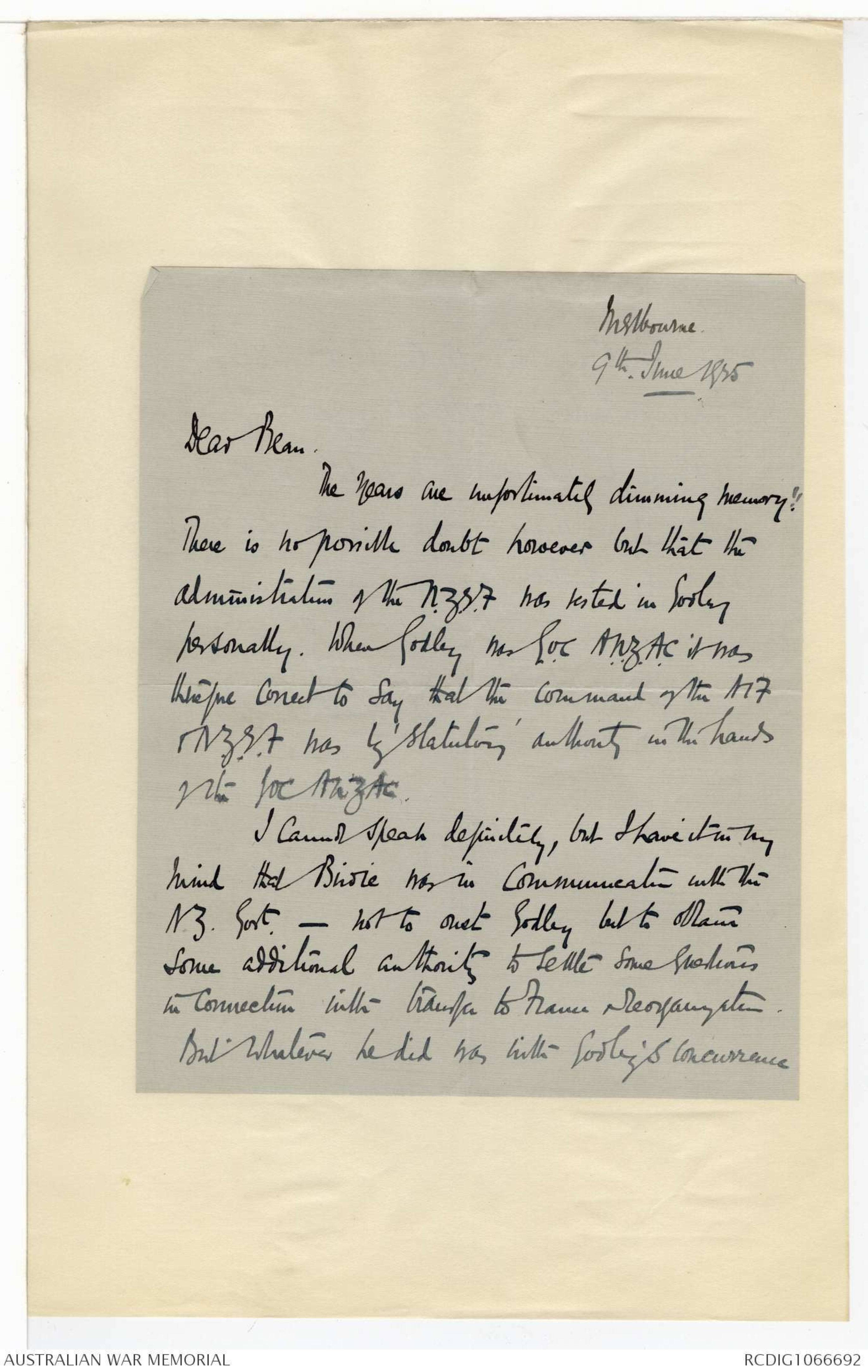
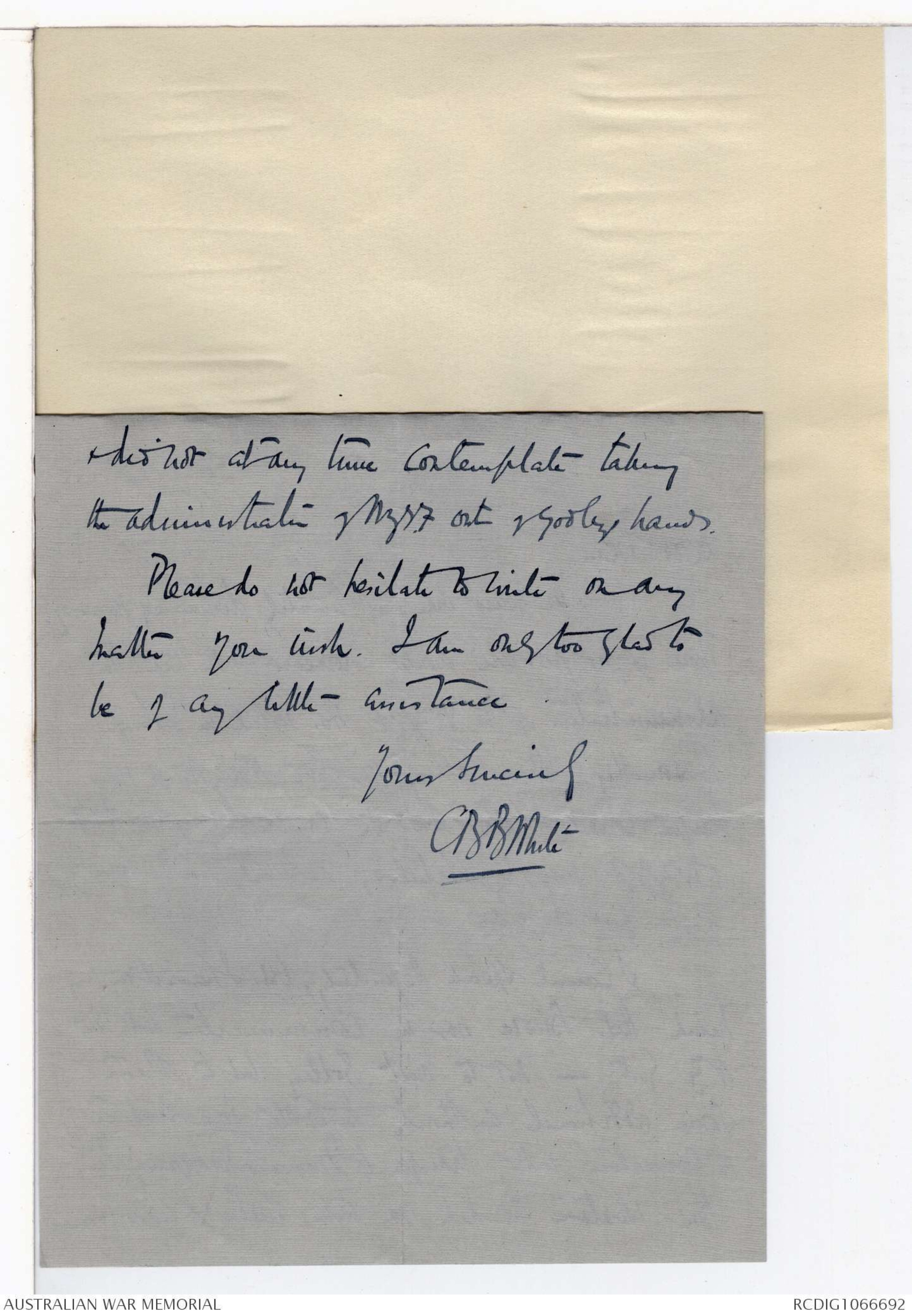
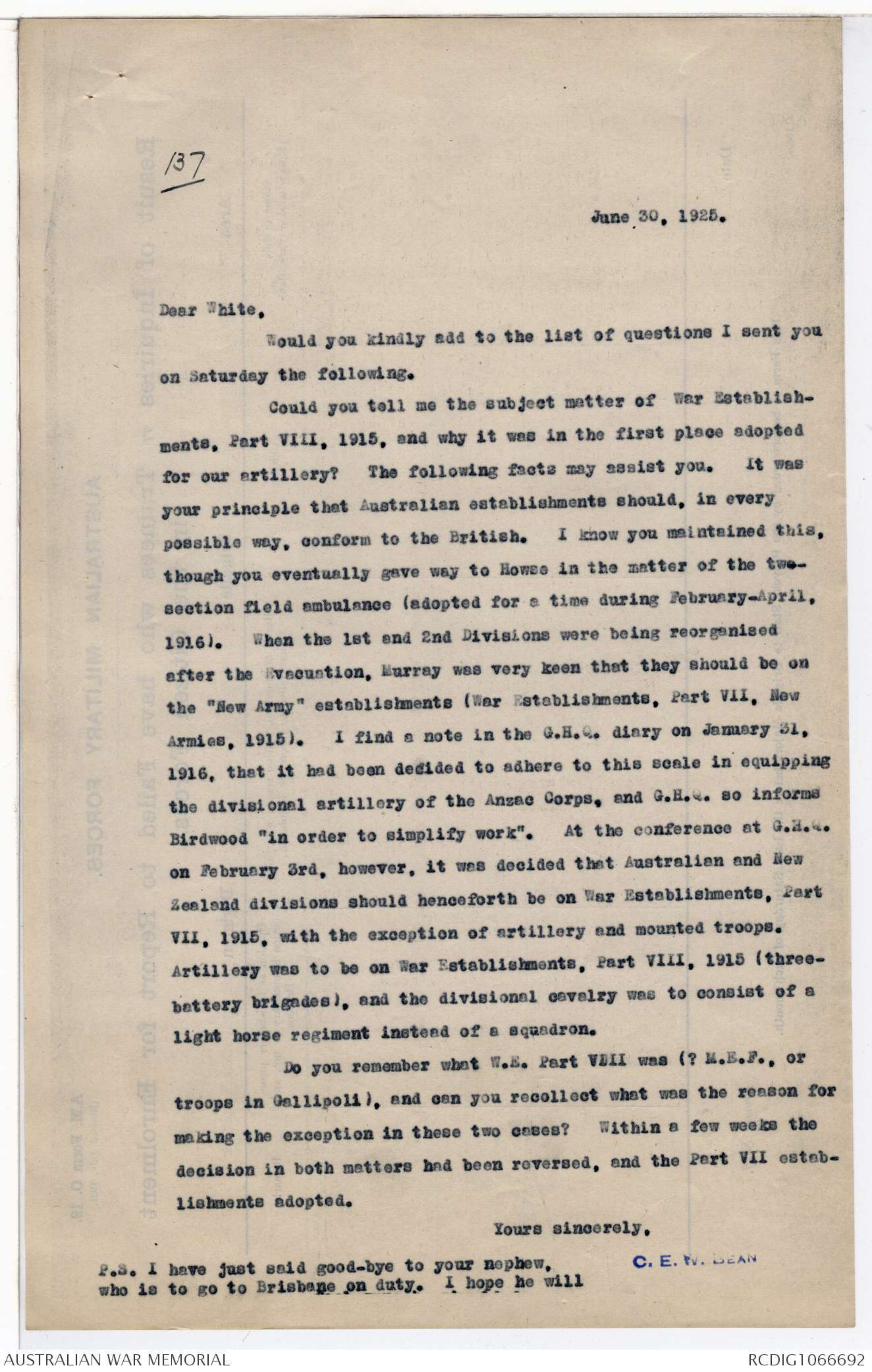
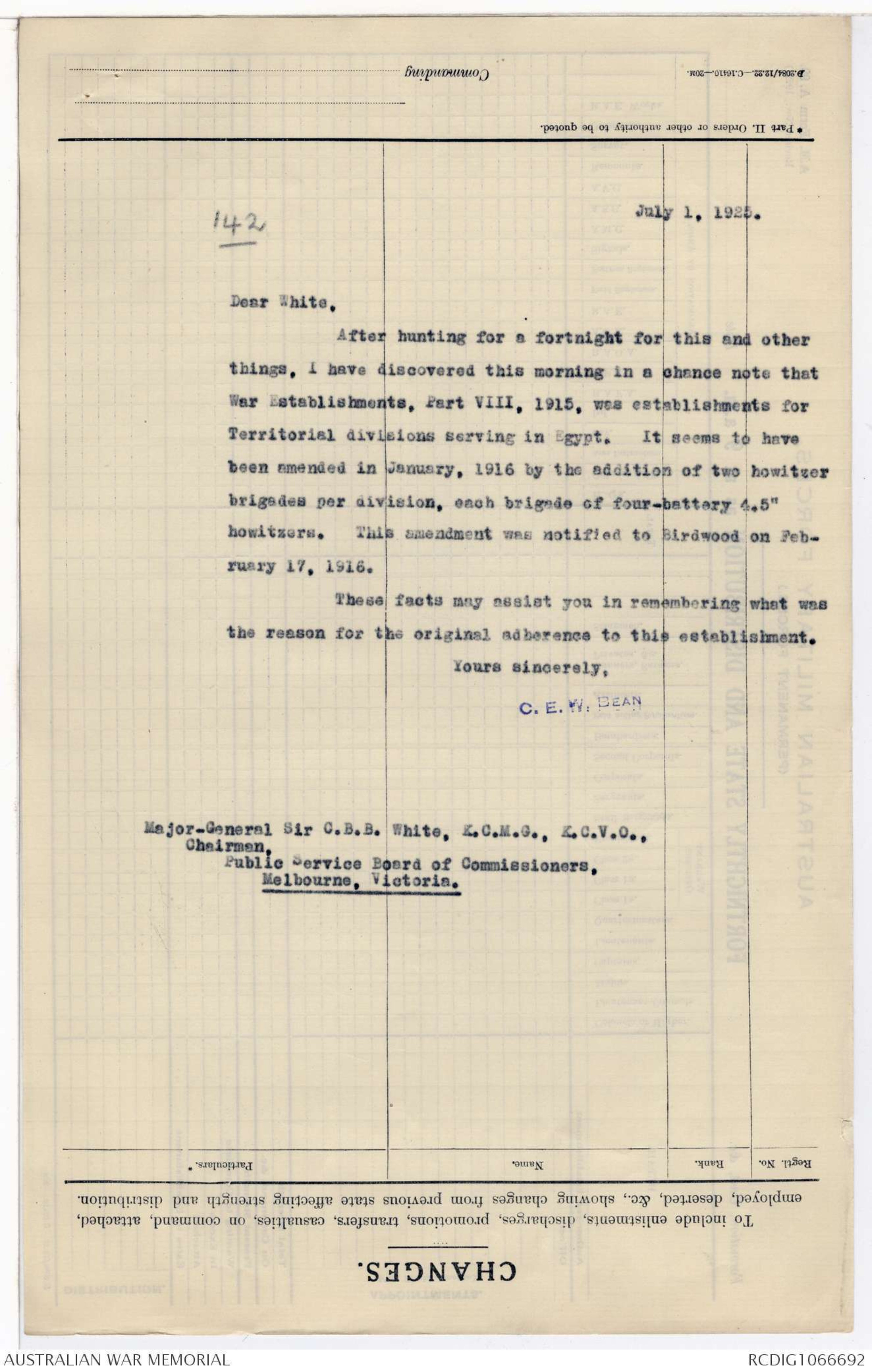
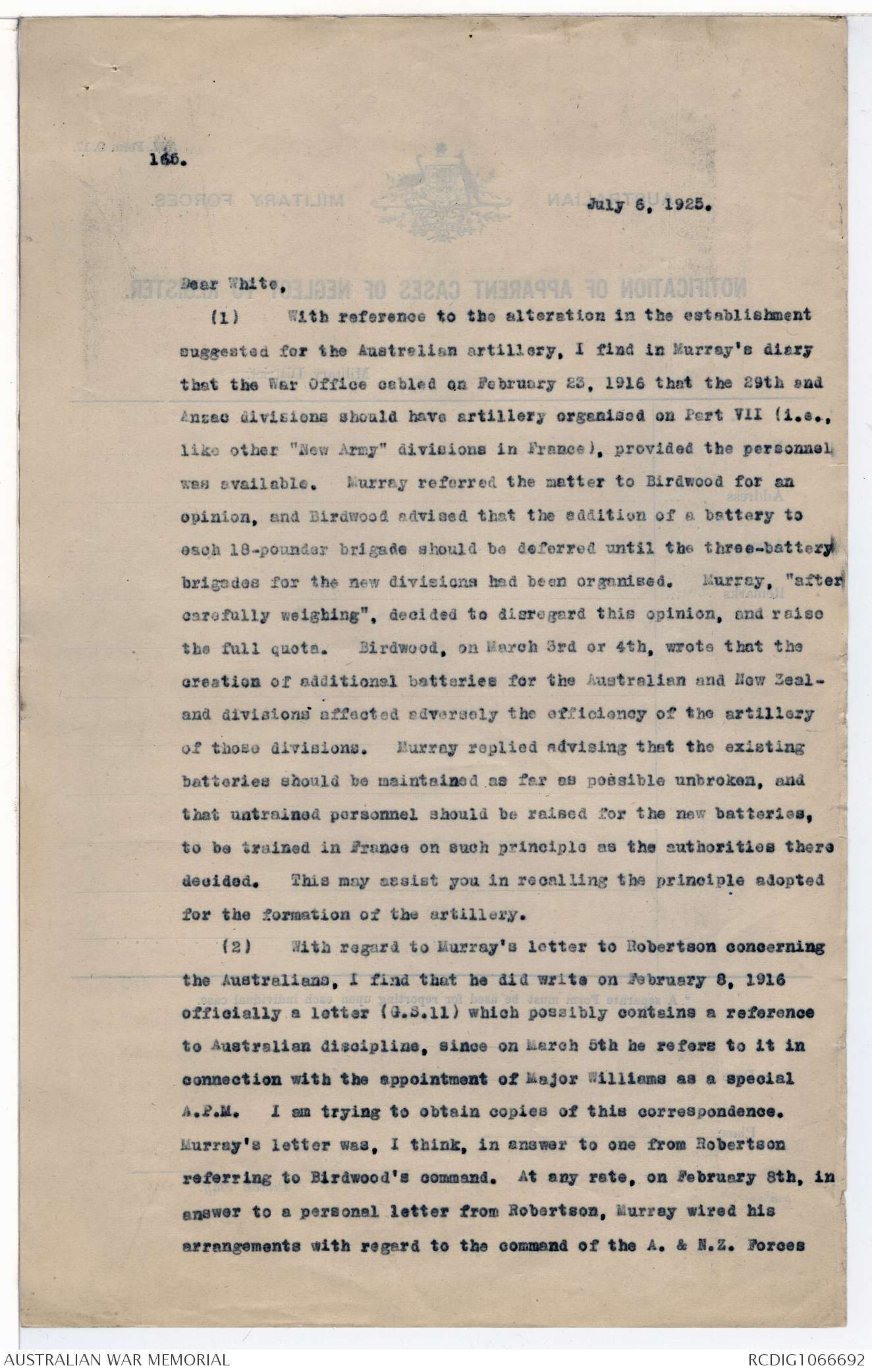
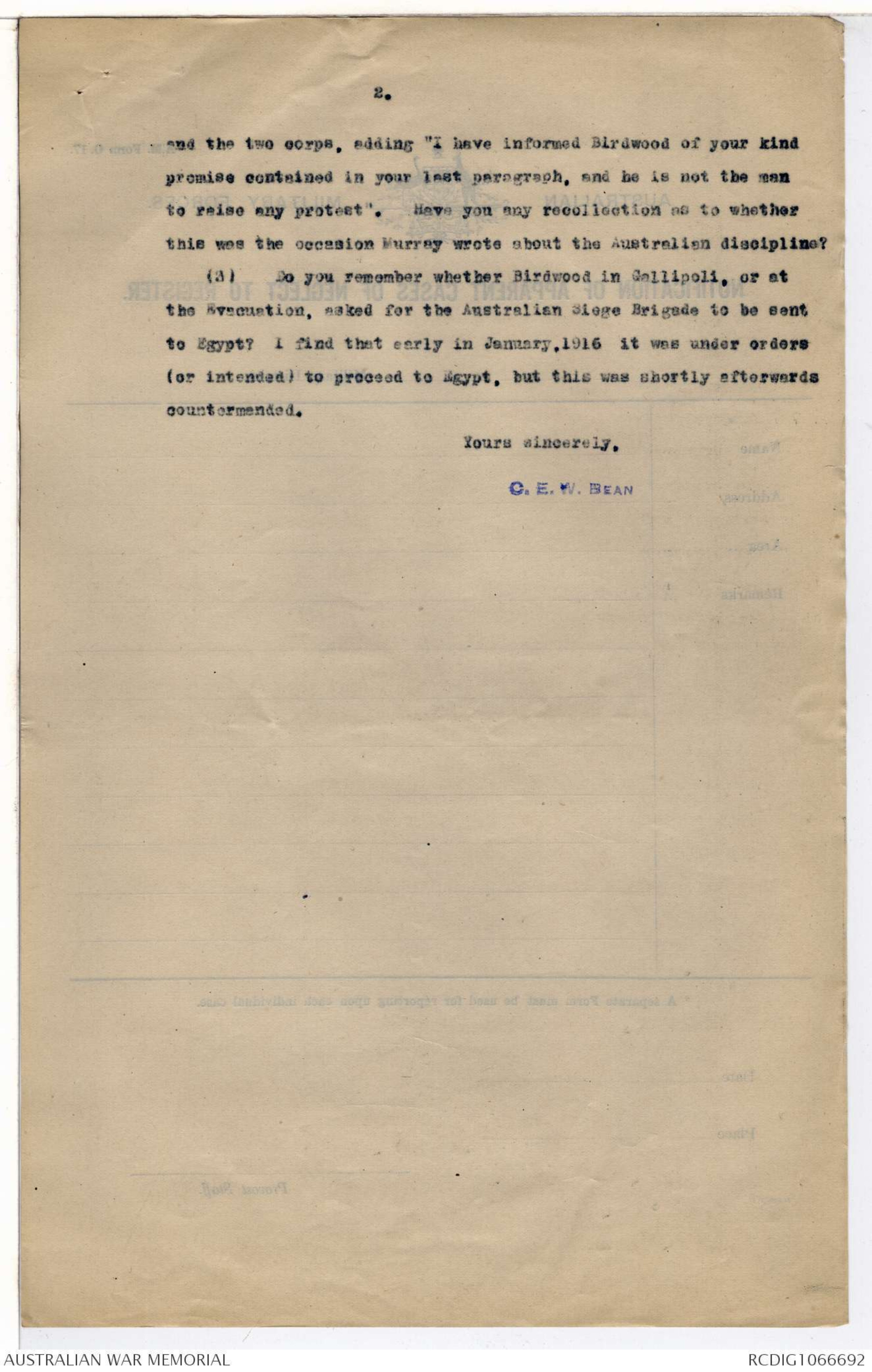
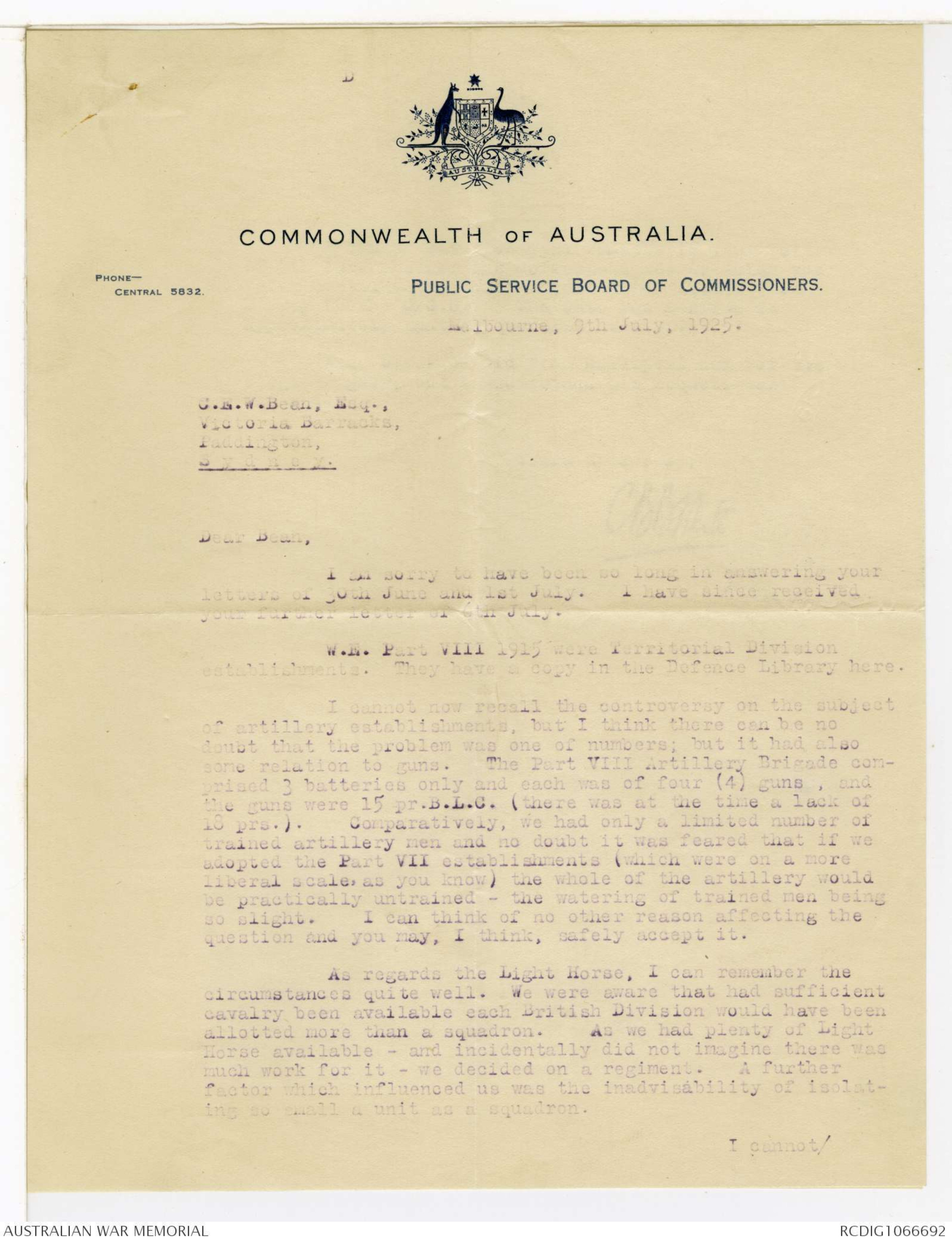

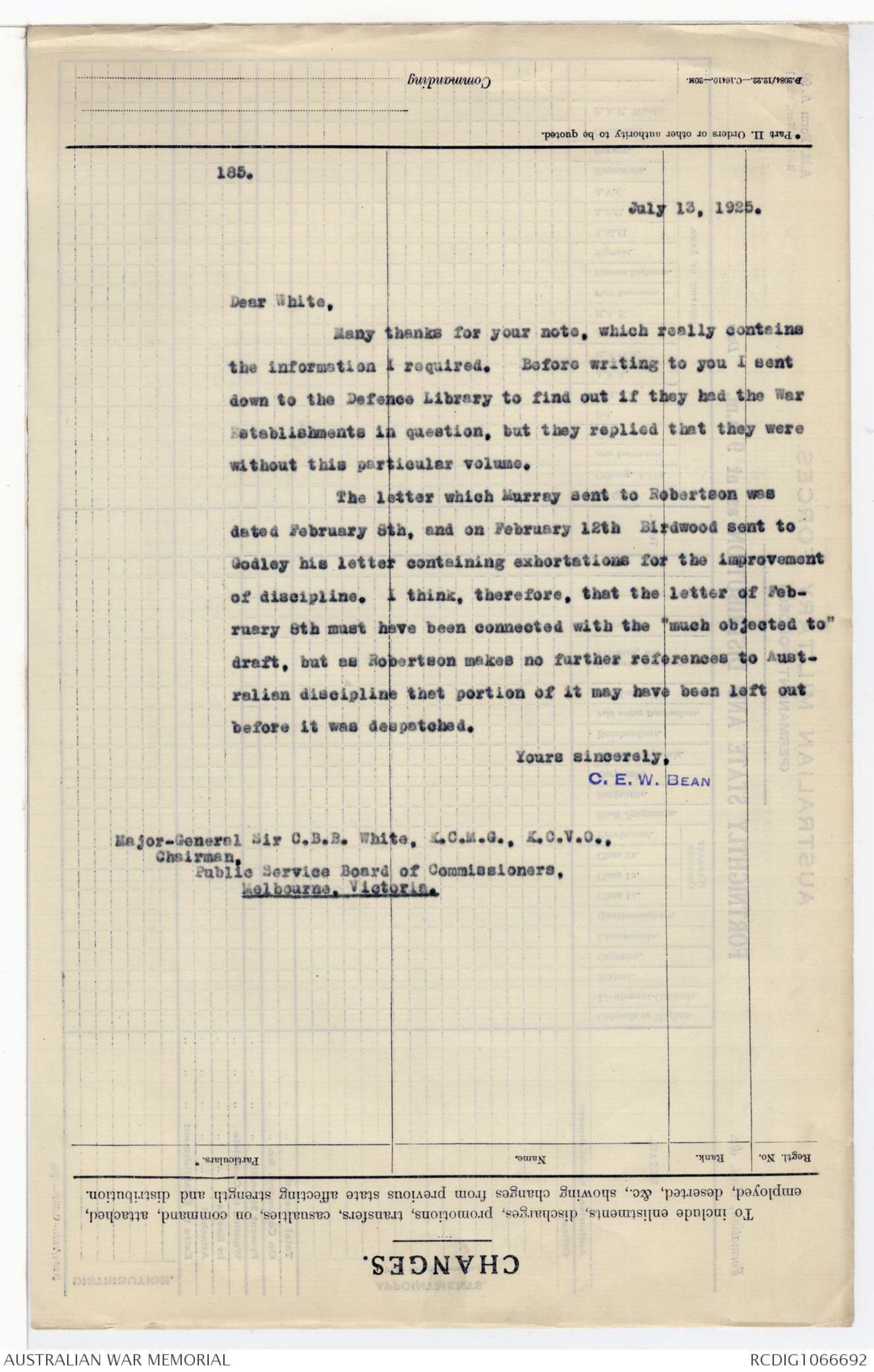
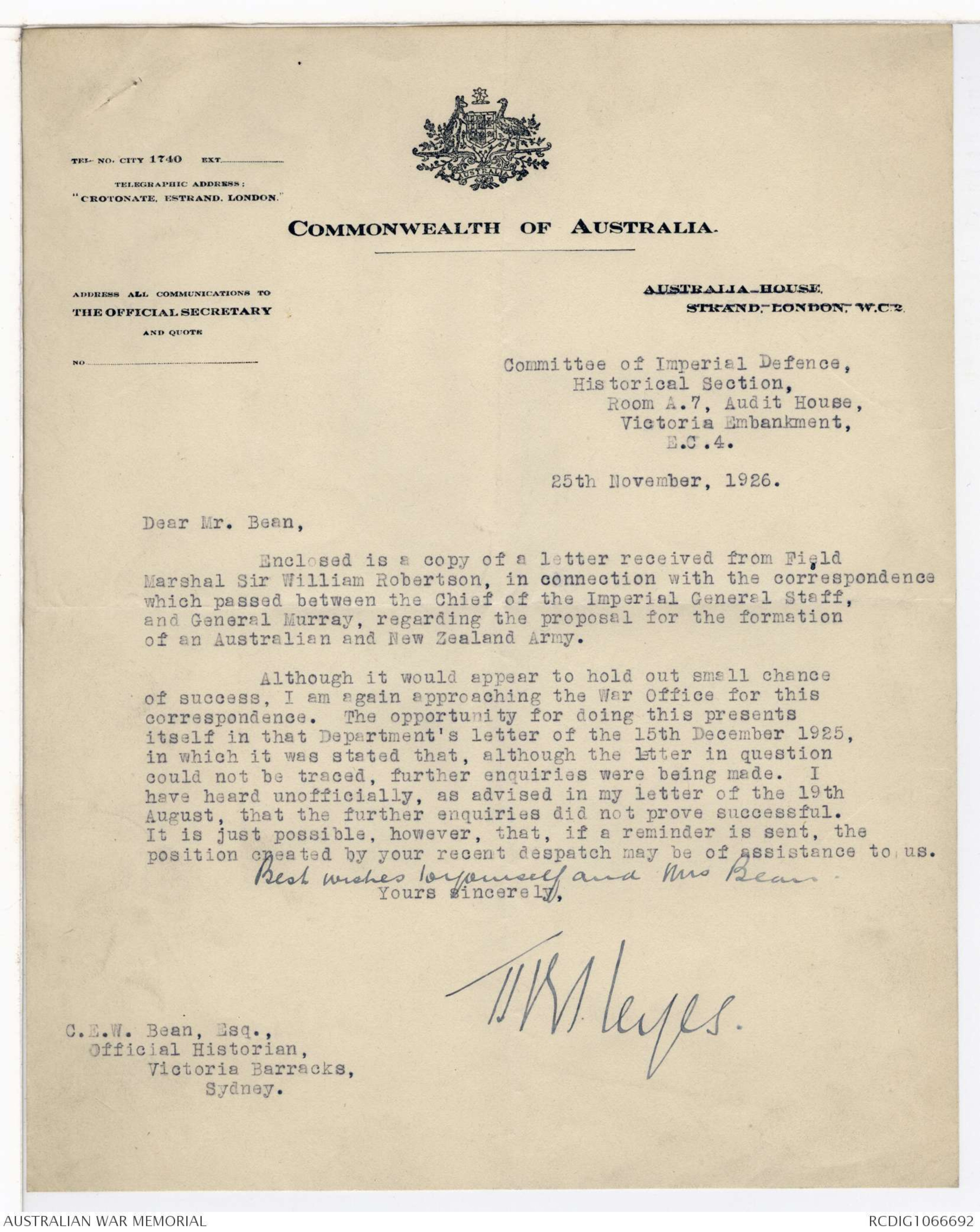
Melbourne
9th June 1925
Dear Bean
The years are unfortunately dimming memory!!
There is no possible doubt however but that the
administration of the N.Z.G.F has rested in Godley
personally. When Godley was G.O.C. A.N.Z.A.C it was
therefore correct to say that the command of the AIF
& N.Z.G.T was by statutory authority in the hands of the
GOC ANZAC.
I cannot speak definitely, but I have it in my
mind that Birdie was in communication with the
N.Z.Govt - not to oust Godley but to obtain
some additional authority to settle some questions
in connection with transfer to France & reorganization.
But whatever he did was with Godley's concurrence
& did not at any time contemplate taking
the administration of NZGT out of Godley's hands.
Please do not hesitate to write on any matter you wish. I am only too glad to
be of any little assistance.
Yours Sincerely
C B B White
June 30, 1925.
Dear White,
Would you kindly add to the list of questions I sent you
on Saturday the following.
Could you tell me the subject matter of War Establishment,
Part VIII, 1915, and why it was in the first place adopted
for our artillery? The following facts may assist you. It was
your principle that Australian establishments should, in every
possible way, conform to the British. I know you maintained this.
though you eventually gave way to Howes in the matter of the two-
section field ambulance (adopted for a time during February-April,
1916). When the 1st and 2nd Divisions were being reorganised
after the evacuation, Murray was very keen that they should be on
the "New Army" establishments (War Establishments, Part VII, New
Armies, 1915). I find a note in the G.H.Q diary on January 31,
1916, that it had been decided to adhere to this scale in equipping
the divisional artillery of the Anzac Corps. and G.H.Q. so informed
Birdwood "in order to simplify work". At the conference at G.H.Q.
on February 3rd, however, it was decided that Australian and New
Zealand divisions should henceforth be on War Establishments, Part
VII, 1915, with the exception of artillery and mounted troops.
Artillery was to be on War Establishments, Part VIII, 1915 (three-
battery brigades), and the divisional cavalry was to consist of a
light horse regiment instead of a squadron.
Do you remember what W.E. Part VIII was (?M.E.F., or
troops in Gallipoli), and can you recollect what was the reason for
making the exception in these two cases? Within a few weeks the
decision in both matters had been reversed, and the Part VII
establishment adopted.
Yours sincerely,
C.E.W. BEAN
P.S. I have just said good-bye to your nephew,
who is to go to Brisbane on duty. I hope he will
142 July 1, 1915.
Dear White,
After hunting for a fortnight for this and other
things, I have discovered this morning in a chance note that
War Establishments, Part VIII, 1915, was establishments for
Territorial division serving in Egypt. It seems to have
been amended in January, 1916 by the addition of two howitzer
brigades per division. each brigade of four-battery 4.5"
howitzers. This amendment was notified to Birdwood on
February 17, 1916.
These facts may assist you in remembering what was
the main reason for the original adherence to establishment.
Yours sincerely,
C.E.W. BEAN
Major- General Sir C.B.B. White, K.C.M.G., K.C.V.O.,
Chairman,
Public Service Board of Commissioners,
Melbourne, Victoria.
146.
July 6, 1925.
Dear White,
(1) With reference to the alteration in the establishment
suggested for the Australian artillery, I find in Murray's diary
that the War Office cabled on February 22, 1914 that the 29th and
Anzac divisions should have artillery organised on Part VII (i.e.,
like other "New Army" divisions in France), provided the personnel
was available. Murray referred the matter to Birdwood for an
opinion, and Birdwood advised that the addition of a battery to
each 10-pounder brigade should be deferred until the three-battery
brigades for the new divisions had been organised. Murray, "after
carefully weighing", decided to disregard this opinion, and raise
the full quote. Birdwood, on March 3rd or 4th, wrote that the
creation of additional batteries for the Australian and New Zeal-
and divisions affected adversely the efficiency of the artillery
of those divisions. Murray replied advising that the existing
batteries should be maintained as far as possible unbroken, and
that untrained personnel should be raised for the new batteries,
to be trained in France on such principle as the authorities there
decided. This may assist you in recalling the principle adopted
for the formation of the artillery.
(2) With regard to Murray's letter to Robertson concerning
the Australians, I find that he did write on February 8, 1916
officially a letter (G.S.11) which possibly contains a reference
to Australian discipline, since on March 5th he refers to it in
connection with the appointment of Major Williams as a special
A.P.M. I was trying to obtain copies of these correspondence.
Murray's letter was, I think, in answer to one from Robertson
referring to Birdwood's command. At any rate, on February 8th, in
answer to a personal letter to Robertson, Murray wired his
arrangements with regard to the command of the A. & N.Z. Forces
2.
and the two corps, adding "I have informed Birdwood of your kind
promise contained in your last paragraph, and he is not the man
to raise any protect". Have you any recollection as to whether
this was the occasion Murray wrote about the Australian discipline?
(3) Do you remember whether Birdwood in Gallipoli, or at
the Evacuation, asked for the Australian Siege Brigade to be sent
to Egypt? I find that early in January,1916 it was under orders
(or intended) to proceed to Egypt, but this was shortly afterwards
countermended.
Yours sincerely,
C. E. W. BEAN
PHONE-
CENTRAL 5832.
COMMONWEALTH OF AUSTRALIA
PUBLIC SERVICE BOARD OF COMMISSIONERS
Melbourne, 9th July, 1925
C.E.W.Bean, Esq.,
VICTORIA BARRACKS,
Paddington,
S Y D N E Y
Dear Bean,
I am sorry to have been so long in answering your
letters of 30th June and 1st July. I have since received
your recent letter of 4th July.
W.E. Part VIII 1915 were Territorial Division
establishments. They have a copy in the Defence Library here.
I cannot now recall the controversy on the subject
of artillery establishments, but I think there can be no
doubt that the problem was one of numbers; but it had also
some relation to guns. The Part VIII Artillery Brigade com-
prised 3 batteries only and each one was of four (4) guns, and
the guns were 15-pr.B.L.G. ( there was at the time a lack of
18-prs.). Comparatively, we had only a limited number of
trained artillery men and no doubt it was forced that if we
adopted the Part VIII establishments (which were on a more
liberal scale, as you know) the whole of the artillery would
be practically untrained - the watering of trained men being
so slight. I can think of no other reason affecting the
question and you may, I think, safely accept it.
As regards the Light Horse, I can remember the
circumstances quite well. We were aware that had sufficient
cavalry been available each British Division would have been
allotted more that a squadron. As we had plenty of Light
Horse available - and incidentally did not imagine there was
much work for it - we decided on a regiment. A further
faster which influenced us was the inadvisability of isolat-
ing as a small unit as a squadron.
I cannot/
2.
I cannot say from your remarks in your letter
of 6th July whether the correspondence to which you
refer contains the "much objected to" letter from
Murray to the C/G.S. The date you mention is
approximately that in question however.
Yes, Birdwood did from Gallipoli ask for the
siege brigade, but I understand his request was
refused.
Yours sincerely,
CBBWhite
185.
July 13, 1925.
Dear White, Many thanks for your note, which really contains
the information I required. Before writing to you I sent
down to the Defence Library to find out if they had the War
Establishments in question, but the replied that they were without this particular volume.
The letter which Murray sent to Robertson was
dated February 8th, and on February 12th Birdwood sent to
Godley his letter containing exhortations for the improvement
of discipline. I think, therefore, that the letter of Feb-
ruary 8th must have connected with the "much objected to"
draft, but as Robertson makes no further references to Aust-
tralian discipline that portion of it may have been left out
before it was despatched.
Yours sincerely
C. E. W. BEAN
Major-General Sir C.B.B. White, K.C.M.G., K.C.V.O.,
Chairman,
Pubic Service Board of Commissioners,
Melbourne, Victoria
TEL. NO. CITY 1740 EXT___________
TELEGRAPHIC ADDRESS:
"CROTONATE, ESTRAND, LONDON."
ADDRESS ALL COMMUNICATIONS TO
THE OFFICIAL SECRETARY
AND QUOTE
NO____________________
COMMONWEALTH OF AUSTRALIA.
AUSTRALIA HOUSE,
ESTRAND, LONDON.
Committee of Imperial Defence,
Historical Section,
Room A.7, Audit House
Victoria Embankment,
E.C.4.
25th November, 1926.
Dear Mr. Bean,
Enclosed is a copy of a letter received from Field
Marshall Sir William Robertson, in connection with the correspondence
which passed between the Chief of the Imperial General Staff,
and General Murray, regarding the proposal for the formation
of an Australian and New Zealand Army.
Although it would appear to hold out small chance
of success, I am again approaching the War Office for this
correspondence. The opportunity for doing this presents
itself in the Department's letter of the 15th December 1925,
in which it was stated that, although the letter in question
could not be traced, further enquiries were being made. I
have heard unofficially, as advised in my letter of the 19th
August, that the further enquiries did not prove successful.
It is just possible, however, that, if a reminder is sent, the
position created by your recent despatch may be of assistance to us.
Best wishes to yourself and Mrs. Bean.
Yours sincerely,
THSHeyes.
C.E.W. Bean, Esq.
Official Historian,
Victoria Barracks,
Sydney.
 Sam scott
Sam scottThis transcription item is now locked to you for editing. To release the lock either Save your changes or Cancel.
This lock will be automatically released after 60 minutes of inactivity.